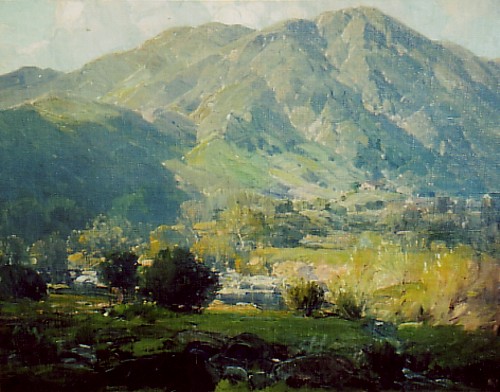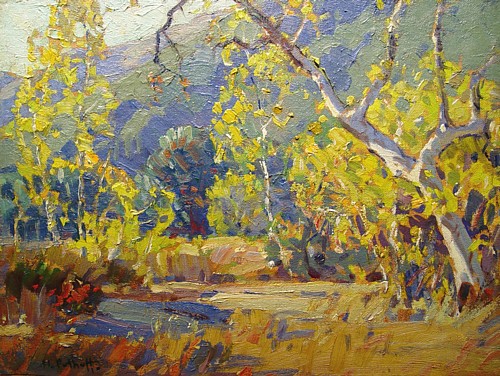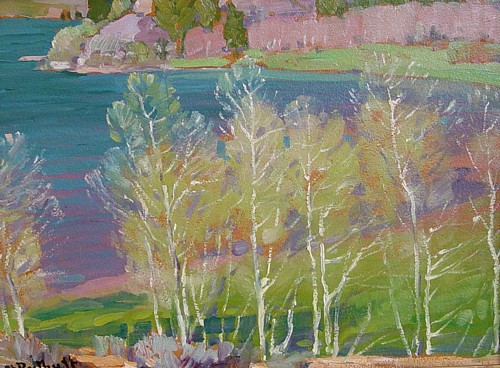Hanson Puthuff Biography
Hanson Puthuff was born in 1875 inWaverly, Missouri. He is primarily remembered for his Californialandscapes and desert paintings, and his involvement in the SouthernCalifornia art world in the early 20th century. His paintings ofrolling hills, canyons, and atmospheric effects of Southern California,the Sierras, and desert scenes are widely admired.
Puthuff's childhood was filled with both uncertainty and strife. He wasborn to a struggling carpenter, Alonzo Augustus Duvall, and his wife, Mary Anne Lee. When Puthuff was two, his mother died and he was givento the care of her close friend Elizabeth Stanley Puthuff, a young Civil War widow who supported herself as a seamstress. She became his surrogate mother, and he later assumed her name. Puthuff remained closeto her, with the exception of a period of eight years, when his fathertook him at age six to live with various relatives in Kentucky, and later with himself for a short time in Oklahoma.
After studying at the Chicago ArtInstitute, Puthuff and his foster mother moved to Colorado in 1889. She was responsible for his art training in 1893 at the University of DenverArt School and then the Chicago Academy of Fine Arts. Through friends and relatives she then helped him start a career in commercial art,-first as a mural painter in Peoria, Illinois, and later as a poster and sign painter for an advertising firm in Denver.
He arrived in Los Angeles in 1903, as an established pictorial artist, and soon had a job at five dollars a day. He worked for the next twenty-three years as a commercial artist, primarily painting billboards as well as a theater scene painter. He also was a significant teacher of private art classes. His great love, however, was "plein aire" landscape painting, which he took up full time in 1926.
Easel painting grew quite naturally out of his professional commercial work. When painting billboards, Puthuff would be transported by horse-drawn wagon out to a billboard and deposited for the day. When he and his helpers finished sign painting, they would often set up easels and sketch and paint while they waited for the return of the wagon. When Puthuff first came to California he had been mainly interested in figural painting, but he found this new land so paintable that he concentrated almost exclusively on landscapes from that time on.

"Malibu"
SOLD
Shortly after leaving commercial art, the Santa Fe Railroad offered Puthuff one of his first commissions. He was asked to paint a series of different views of the Grand Canyon, which the railroad would use for advertising and promotional purposes. These works, Grand Canyon, were shown to the public in a 1927 exhibition in the offices of the railroad. They remained there for many years until their purchase by the Fleischer Museum. Puthuff also painted backgrounds for the Santa Fe Railroad model train exhibits in various cities.
Living in La Canada and Corona del Mar, Puthuff painted desert scenes throughout California and frequently accompanied Edgar Payne on painting trips to Canyon de Chelly in Arizona. He loved the bright colors and open space of Navajo country.
In addition to his lyrical landscapes, which he often painted along the coast south of Los Angeles, in the foothills of the San Gabriel Mountains, and among the desert buttes of the Southwest, Puthuff was responsible for the backgrounds of the habitat groups at the Los Angeles County Museum of History, Science, and Art. This work led to a commission for Puthuff to paint backgrounds for the Theodore Roosevelt Memorial in the American Museum of History in New York. After weeks of work both at Roosevelt's Elk Horn Ranch in North Dakota and in New York, he completed three panoramic dioramas depicting the ranch.
His work is often considered to be stylistically akin to that of William Wendt, although with a wider chromatic spectrum. Puthuff is also particularly identified with the depiction of eucalyptus trees, as are Jean Mannheim, Dana Bartlett, Edgar Payne, and Anna Althea Hills, and Paul Lauritz.
In addition to his own artistic achievements, Puthuff was an activist in the art community. He was partly responsible for the formation of the two most important artists' organizations of the period, the California Art Club and the Art Students League of Los Angeles, which he helped found with Norwegian- born art writer and close friend Antony Anderson, art critic for the Los Angeles Times. Puthuff had introduced study from the nude in his private classes in 1903, and in 1906 these were transferred to the Blanchard building in Los Angeles, and the school later took the name the Art Students League of Los Angeles.
He became associated with a group called the Garvanza Circle, named for the Garvanza district of eastern Los Angeles, which included such artists as Fernand Lungren, Carl Oscar Borg, Maynard Dixon, Granville Redmond, Elmer Wachtel, and others who were inspired by southwestern cultural heritage.
Puthuff's private life spanned two thirty-year long marriages. The first began in 1910, when he married May Longest, a commercial artist and co-worker. They had five children, Lee and Duvall, identical twin boys, and later, Robert, Paul, and Matilda, and the family lived in the Los Angeles area. After May's death, Puthuff married Louise Ashbridge White in 1940, a relationship that lasted until his death thirty-two years later.
He won numerous awards including a Diploma from the Alaska-Yukon Exposition in 1892 and Silver Medals at the Panama-California Exposition in 1915. He was a member of numerous clubs, including the California Art Club, the Laguna Beach Art Association, the Los Angeles Watercolor Society, the Pasadena Society of Artists, the Salmagundi Club of New York, the San Francisco Art Association, and the Southern States Art League.
Hanson Puthuff died May 12, 1972, in Corona del Mar, California.
Sources: Michael David Zellman, 300 Years of American Art Donald Hagerty, Canyon de Chelly Wesley Jessup and Jean Stern, Hanson Puthuff, California Colors Edan Hughes, Artists in California, 1786-1940

"Southern California"
SOLD

"June Lake"
SOLD
info@kargesfineart.com for further information

